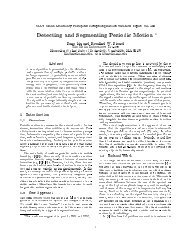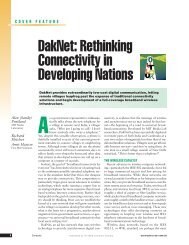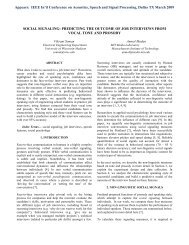Social Serendipity: Proximity Sensing and Cueing - Human ...
Social Serendipity: Proximity Sensing and Cueing - Human ...
Social Serendipity: Proximity Sensing and Cueing - Human ...
Create successful ePaper yourself
Turn your PDF publications into a flip-book with our unique Google optimized e-Paper software.
Conferences. Conferences are an obvious place for social proximity sensing badges<br />
because badges are already prevalent <strong>and</strong> accepted. Large corporations spend<br />
hundreds of thous<strong>and</strong>s of dollars sending employees to industry conferences, yet there<br />
is little to show in terms of return on this investment. Quantifying the projects <strong>and</strong><br />
people that individuals were exposed to not only makes it easier to write trip reports,<br />
but also captures more of a conference's value.<br />
nTag. nTag is a one of the pioneers in the commercial electronic badges market <strong>and</strong><br />
designed a badge to improve networking of event participants. Profiles of the participants<br />
are transmitted from a PC over IR to the badge. When two badges are aligned<br />
with one another, text on the badges can provide introductions <strong>and</strong> display items the<br />
participants have in common. For additional functionality, the badges can also be<br />
enabled with radio frequency identification (RFID) [19].<br />
IntelliBadge. IntelliBadge uses RFID to capture the location of participants. Because<br />
the devices have no visible output, public displays are used to support a variety of<br />
applications including traffic monitoring between conference halls, <strong>and</strong> determining<br />
how far a participant has walked during the conference [4].<br />
SpotMe. SpotMe is not a traditional badge, but rather a small Linux-based device that<br />
uses short-range RF to communicate with similar devices, in order to provide services<br />
such as introductions, information about other conference participants, <strong>and</strong> searches<br />
for specific individuals [20].<br />
Ubicomp Experience Project. Using inexpensive RFIDs with traditional conference<br />
badges, the Ubicomp Experience Project was able to link profiles describing many of<br />
the conference participants with their actual locations. When users would approach a<br />
tag reader <strong>and</strong> display, relevant 'talking points' would appear on the screen [10].<br />
Private Devices<br />
Despite the benefits of wearing an exposed electronic badge that can be easily spotted<br />
by other individuals, there are situations where this may not be preferable. Other<br />
methods of social proximity sensing have recently been introduced to allow users to<br />
keep the device in their pocket, backpack or purse.<br />
Lovegety. The Lovegety's introduction in Japan in early 1998 was the first commercial<br />
attempt to take introduction systems away from the desktop <strong>and</strong> into reality. Users<br />
input his <strong>and</strong> her responses to a couple questions into the Lovegety; the device then<br />
alerts both users when a mutual match has been found. Gaydar, a similar product specifically<br />
targeted for the gay community, was launched soon afterwards in the United<br />
States [21].<br />
Cell Tower / SMS Locators. Several wireless service providers now offer locationbased<br />
services to mobile phone subscribers using celltower IDs. Users of services such<br />
as Dodgeball.com can expose their location to other friends by explicitly naming their<br />
location using SMS [22].






